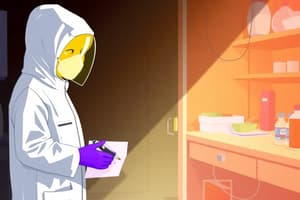Podcast
Questions and Answers
Which of the following is considered a primary barrier in a microbiology laboratory?
Which of the following is considered a primary barrier in a microbiology laboratory?
- Special air ventilation patterns (correct)
- Storing food and drink
- Sinks for hand washing
- Special air ventilation patterns
What is NOT permitted in microbiology laboratories according to the standard practices?
What is NOT permitted in microbiology laboratories according to the standard practices?
- Pipetting by mouth (correct)
- Rolling up loose sleeves
- Wearing lab coat and shoes
What are examples of biological hazards in a microbiology lab?
What are examples of biological hazards in a microbiology lab?
- Sharps, needles, and glasswares
- Radiation hazards and electrical hazards
- Human blood and fluids, human cell lines (correct)
- Chemical hazards and fire hazards
What is the purpose of secondary barriers in a microbiology laboratory?
What is the purpose of secondary barriers in a microbiology laboratory?
Which guidelines are developed to protect workers in microbiological labs?
Which guidelines are developed to protect workers in microbiological labs?
Flashcards are hidden until you start studying
Study Notes
Primary Barriers in a Microbiology Laboratory
- Glass doors and sinks are considered primary barriers in a microbiology laboratory
Standard Practices in Microbiology Laboratories
- Eating, drinking, and smoking are not permitted in microbiology laboratories according to standard practices
Biological Hazards in a Microbiology Lab
- Infectious microorganisms, viruses, and biological toxins are examples of biological hazards in a microbiology lab
Secondary Barriers in a Microbiology Laboratory
- The purpose of secondary barriers in a microbiology laboratory is to provide an additional layer of protection to prevent the exposure of workers and the environment to biological hazards
Guidelines for Protecting Workers in Microbiological Labs
- The Biosafety in Microbiological and Biomedical Laboratories (BMBL) guidelines are developed to protect workers in microbiological labs
Studying That Suits You
Use AI to generate personalized quizzes and flashcards to suit your learning preferences.




